Transforming Small Bathrooms: Design and Decor Tips
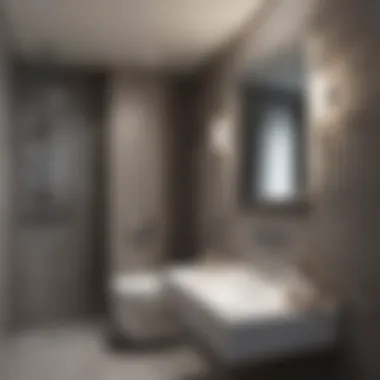
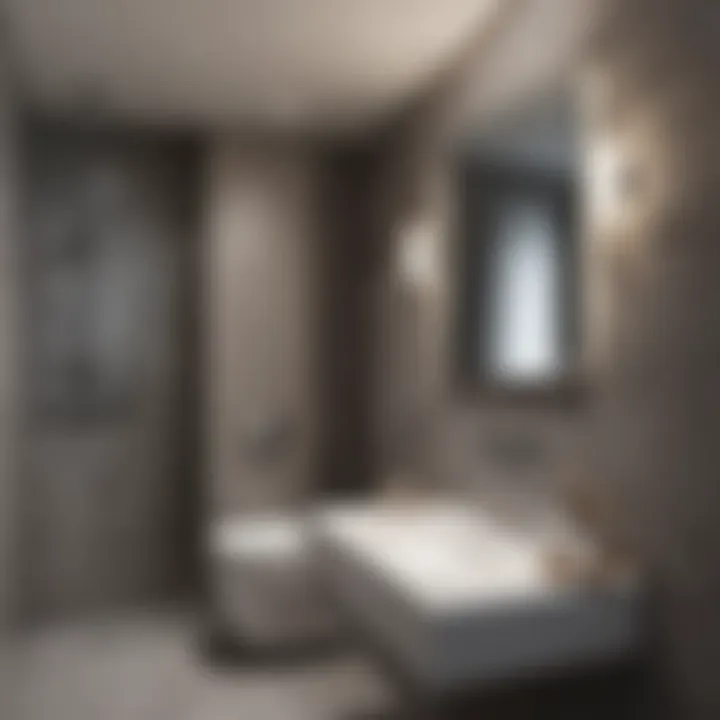
Intro
Decorating a tiny bathroom might seem like a Herculean task, but with the right approach, it can transform into a thriving space that speaks to both functionality and style. When faced with the challenge of limited square footage, every decision—from the color of the walls to the type of fixtures—needs to be precise and well thought out, like piecing together a jigsaw puzzle.
This article aims to guide homeowners and decor enthusiasts, especially those who might feel overwhelmed by the constraints of a small area. Here, we will go beyond surface-level enhancements and delve into the core elements that truly make a bathroom work. From vital design principles to clever storage hacks, every tip is designed to maximize your bathroom's potential while aligning with your personal style.
The conversation will also touch on the significance of lighting and color choices, which can create illusions of space and warmth. Plus, we will showcase real-life transformations to offer visual inspiration.
As we embark on this comprehensive journey to decorate tiny bathrooms, we will unearth ways to ensure that even the modest confines of your home can resonate with serenity and sophistication.
Understanding the Challenges of a Small Bathroom
In the realm of home design, tiny bathrooms can often feel like a maze that one must navigate cautiously. Understanding the challenges presented by these compact spaces is crucial for anyone looking to create a functional and stylish bathroom. When square footage is at a premium, every decision — from the color on the walls to the size of fixtures — holds weight. A deeper grasp of these challenges can help homeowners turn potential limitations into innovative solutions.
Common misconceptions abound when it comes to small bathrooms. Many individuals assume that limited space equates to limited style. In reality, recognizing the particular hurdles posed by small dimensions allows for more tailored, creative design choices. Homeowners can embrace practicality without sacrificing aesthetics. Ultimately, the key lies in understanding that a small bathroom can also be a sanctuary, a hidden gem waiting to be polished.
Common Size Limitations
When addressing common size limitations in a small bathroom, it’s essential to consider both physical measurements and spatial arrangements. Many bathrooms often have awkward layouts that hinder proper functionality. For instance, a closet located awkwardly might take up vital square footage or restrict access to essential fixtures. Bathroom layouts typically have standardized sizes, but many homes feature spaces that don’t adhere strictly to these norms.
- Width constraints can make it challenging to fit in conventional-sized fixtures.
- Height limitations may affect shelving and storage options, leading to overcrowded spaces.
- Shape issues, such as oblong layouts or corners that can’t fit standard-size tubs or vanities, can stifle possibilities.
The reality is, decision-making must revolve around these limitations. Compact vanities can free up room, and corner sinks can optimize space while maintaining functionality. Engaging with these constraints creatively opens the door to innovative design solutions that transform those challenges into a beautifully designed bathroom.
Psychological Effects of Small Spaces
Beyond the physical aspects, small bathrooms come with psychological implications. A compact space can feel stifling if not designed mindfully, possibly leading to feelings of discomfort or anxiety. Studies show that cramped environments can trigger stress responses; thus, converting a small bathroom into a serene oasis is paramount.
Here, spatial perception plays a vital role. Factors influencing emotional responses may include:
- Light: Maximizing natural light creates an airy, spacious feel. Integrating mirrors can reflect light and amplify brightness.
- Color: Opting for light, neutral palettes minimizes visual clutter, making spaces feel larger.
- Clutter: A densely packed bathroom can feel suffocating. Keeping surfaces clear and implementing organized storage can curtail chaos.
In essence, acknowledging these psychological effects is equally as important as addressing physical restrictions. By focusing not just on aesthetics, but also on how the space feels, homeowners can craft a tiny bathroom that fosters tranquility rather than tension.
Essentials of Small Bathroom Design
Designing a small bathroom is more than just a game of fitting things in; it's an art that marries functionality with style. When it comes to small spaces, every inch matters. This section will highlight the importance of understanding the essentials of small bathroom design to transform even the tiniest of spaces into a restful retreat.
Principles of Scale and Proportion
Understanding scale and proportion is crucial in small bathroom design. These principles guide the selection and arrangement of elements to ensure they complement each other harmony. In essence, scale refers to the size of an object in relation to other objects, while proportion looks at the relationship between parts of a whole.
When you choose fixtures or furniture for your tiny sanctuary, consider their size relative to the room. A massive vanity can easily overpower a small bathroom, making it feel cramped and uninviting. Conversely, an overly petite piece may get lost in the space, leaving the area looking stark and unfinished. Finding a balance is key.
Here are some tips to apply these principles effectively:
- Select appropriately sized fixtures: Opt for a narrow sink or a compact toilet, such as the Kohler K-6299-0 Loure model, which can fit snugly without taking up too much space.
- Use reflective surfaces: Mirrors can create an illusion of depth. Consider a large wall mirror to heighten the feeling of spaciousness.
- Ensure visual continuity: Maintain similar colors and materials throughout to avoid jarring contrasts that can lead to confusion and discordance in a small area.
Creating Focal Points
In a small bathroom, creating a focal point can draw the eye and elevate the overall design. A well-placed focal point does not only serve aesthetic purposes but also contributes to a sense of organization and balance.
You could consider several points of focus:
- Artistic Lighting: A striking light fixture, like an antique pendant light, can serve as a perfect centerpiece. Its glow can reflect a cozy ambiance, transforming a typical washroom into a welcoming haven.
- Decorative Tiles: A feature wall adorned with colorful tiles can add character to the room and create interest. Imagine stepping into your bathroom and being greeted by a beautifully patterned tile accent above the sink.
- Distinctive Vanities: Instead of standard cabinets, a vintage dresser repurposed as a vanity can become a unique and functional focal point. Pair it with a stylish sink to enhance the overall appeal.
"A small bathroom doesn’t have to feel confined. Choosing the right focal points can make it feel expansive and inviting."
Selecting Color Schemes and Finishes
When it comes to associating moods with spaces, color schemes and finishes play a pivotal role in a tiny bathroom. A well-thought-out palette can not only enhance the perceived size of the area, but it also sets the tone for relaxation and rejuvenation. Given the limited square footage of a small bathroom, your selections are crucial to achieving the desired aesthetics and functionality.
Opting for colors that reflect light and create depth can create an illusion of space. For example, a fresh coat of soft white or pastel shades can work wonders in making cramped quarters feel open and airy. However, it's also important not to overlook the finishes used in combination with the colors. Glossier surfaces tend to reflect light better, enhancing brightness, while matte finishes can add a cozy warmth but may absorb some luminosity. Striking a balance between these elements is key for creating a harmonious environment.
Light Colors and Their Impact
Light colors are often the unsung heroes in the design of small bathrooms. They help in creating that much-coveted airy feeling. A light palette can make even the smallest of bathrooms feel expansive. Soft whites, pale blues, and gentle greens do more than just brighten up a room; they carry subtle elegance.
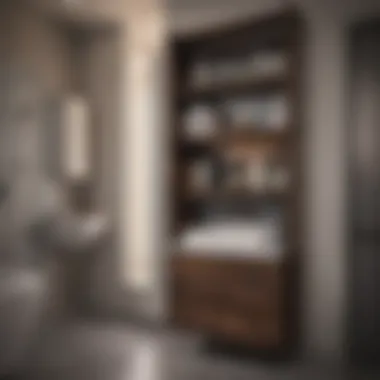
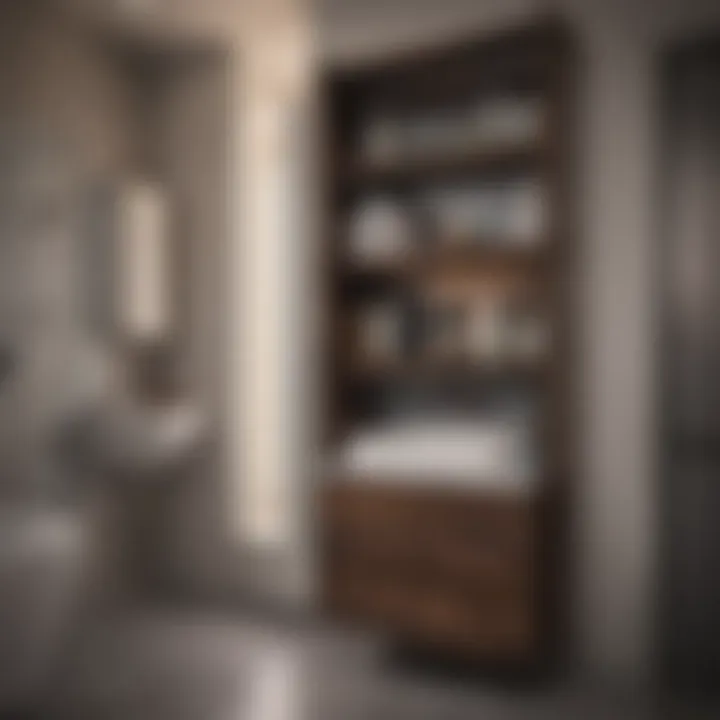
- Psychological Effects: Light colors tend to evoke feelings of tranquility. They can contribute to a calming atmosphere, which is particularly important in a bathroom setting where relaxation is sought.
- Reflective Qualities: Incorporating elements like a polished porcelain tile or gloss-finished cabinetry can amplify this effect. It allows light to bounce around the room, countering any potential feelings of claustrophobia.
- Versatility: Light colors also provide a flexible backdrop for accessories and feature pieces. You can hijack attention by using vibrant towels or artwork that can stand out against a neutral background.
In sum, choosing light colors can be an excellent strategy when working with limited space. It increases brightness while offering versatility and soothing vibes.
Texture and Material Choices
Once you have your color palette set, the next consideration is texture and material choices. The way surfaces feel and look can dramatically affect the overall aesthetics and functionality of a small bathroom. It’s about creating visual interest in a compact area without overwhelming it.
- Smooth vs. Textured Surfaces: Using smooth materials, such as sleek tiles or glass, can amplify light and create a clean, crisp appearance. However, incorporating textured elements like woven baskets, wood accents, or even layered textiles can add warmth and personality.
- Accessories Matter: Don't forget about the impact of smaller items. A textured shower curtain or a woven mat can introduce visual depth without cluttering the space.
- Durability and Maintenance: Opt for materials that are not just visually appealing but also durable and easy to maintain. For instance, ceramic tiles are beautiful and come in a variety of textures, but they are also resistant to water and stains, making them an excellent option for high-humidity areas.
Utilizing Space Efficiently
Making the best use of every inch in a small bathroom can feel like solving a mathematical puzzle. The importance of utilizing space efficiently cannot be overstated, as effective use of space directly contributes to both function and aesthetics. Small bathrooms often lack the luxury of square footage; hence, every design decision carries significant weight. By focusing on specific elements such as storage solutions and thoughtful layouts, you can create an environment that's not only practical but also inviting.
Efficiently utilizing space transforms your tiny bathroom from a cramped enclosure to a thoughtfully designed retreat.
Smart Storage Solutions
Vertical Storage Options
When you think of maximizing storage in a small bathroom, vertical storage options spring to mind almost instantly. This kind of arrangement capitalizes on the often-overlooked space above eye level. Racks, cabinets, or even pegboards that stretch towards the ceiling can accommodate a surprising number of items while keeping the floor clear. One key characteristic of vertical storage is its ability to draw the eye upward, which can create an illusion of greater height in the room. This makes it a beneficial choice when trying to change the perception of space.
However, not all vertical solutions are created equal. Some can be cumbersome and disrupt the flow of the room if not placed thoughtfully.
Under-sink Capacity
Many homeowners underestimate the utility of the area under the sink. Under-sink capacity can be a game changer in a small bathroom, offering a hidden storage area to keep cleaning supplies, toiletries, or extra towels neatly stowed away. A well-designed cabinet or a creative open shelf can optimize this often-wasted space. This storage is popular because it offers a double benefit: it hides clutter while remaining easily accessible. However, one drawback is that this space can easily become disorganized if not managed well.
Floating Shelves
Floating shelves are like the icing on the cake when it comes to small bathrooms. They provide a modern and open feel, allowing for the display of decorative items as well as storage for practical necessities. One key characteristic is their ability to fit into any nook or cranny, which is crucial for small spaces that often have awkward corners. These shelves are especially beneficial because they leave the floor space clear, giving an airy feel. On the other side, they require precise installation, and if overloaded, they may not provide the sturdy shelves one would hope for.
Rearranging Layouts
Rethinking your bathroom layout could be the simplest way to improve both function and style. Sometimes, a fresh layout can create new possibilities. For example, moving around the placement of fixtures or adding sliding doors can save considerable space. This not only makes moving around more fluid but can also improve the overall accessibility of the room.
Considerations such as door swings, shower placement, and even the positioning of the toilet can dramatically transform your experience in a small bathroom.
Ultimately, a well-planned rearrangement not only maximizes the area but fosters a more pleasant atmosphere as well.
Choosing Bathroom Fixtures
When aiming to create a small bathroom that is both stylish and functional, the choice of fixtures requires careful consideration. This is not just about aesthetics; it involves selecting elements that suit the limited space, enhance usability, and complement your overall design scheme. Opting for the right fixtures can add significant value to your bathroom while ensuring efficiency and practicality.
In a small bathroom, every inch counts. The fixtures you choose can either open up the space or cause it to feel cramped. Therefore, understanding your options and how they work within the confines of your space is essential. When done thoughtfully, the right fixtures can make your bathroom feel more spacious and organized, ultimately elevating your daily routine.
Compact Vanities and Sinks
Compact vanities and sinks serve as the cornerstone for functionality in a small bathroom. Unlike traditional vanities, which can take up a significant floor area, compact options come in various styles tailored for tight spaces. These smaller units not only conserve space but also make your bathroom appear larger and more inviting.
When selecting a compact vanity, consider the following elements:
- Size and Scale: Measuring the area available for the vanity is critical. Look for pieces that are no more than 30 inches wide; this prevents overwhelming the room.
- Storage Solutions: Choose vanities that provide drawers or shelves, even if they’re small. This added storage helps keep essentials organized.
- Style and Finish: Opt for lighter colors or minimalistic designs. A bright vanity can create a feeling of openness despite the size.
Here’s a tip: Installing a floating vanity can be an excellent way to enhance the illusion of space. By keeping the floor visible, it creates an airy ambience and makes cleaning easier.
Space-saving Toilets and Showers
Space-saving toilets and showers are game changers for tiny bathrooms. These fixtures are designed specifically to fit snugly into compact spaces while still providing comfort and function.
- Toilets: Look for models that are shorter in depth or that have a dual-flush feature. Low-profile toilets save space and can contribute to water efficiency, helping save on utility bills.
- Showers: Walk-in showers without a tub can open the space significantly. Consider corner shower units or rounded options that fit neatly into corners. Also, installing glass doors rather than curtains can make the area feel less congested.
- Wall-mounted Faucets: Installing faucets on the wall frees up counter space and provides a modern touch to your bathroom.
"Choosing the right fixtures in a bathroom transforms it from a mere functional area into a refreshing oasis where every square foot matters."
Incorporating Lighting Wisely
In any design endeavor, lighting plays a pivotal role in shaping the overall ambiance. When it comes to a tiny bathroom, the importance of incorporating lighting wisely can't be overstated. Proper lighting enhances functionality, complements design elements, and can even create the illusion of more space. Without a doubt, getting the lighting right is as crucial as selecting the right tiles or paint colors.
One of the benefits of thoughtful lighting is its capability to evoke the right mood. Soft, warm lighting can turn a sterile space into a cozy retreat, which can be very transformative. In addition to this emotional aspect, well-planned lighting ensures you have adequate visibility for tasks such as grooming or applying makeup, critical activities that often occur in the bathroom.
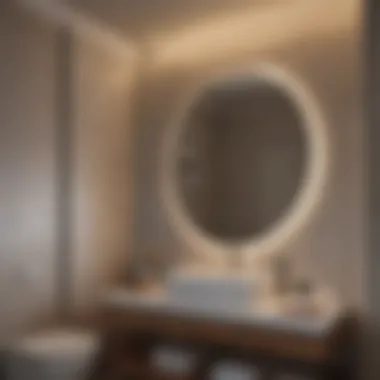
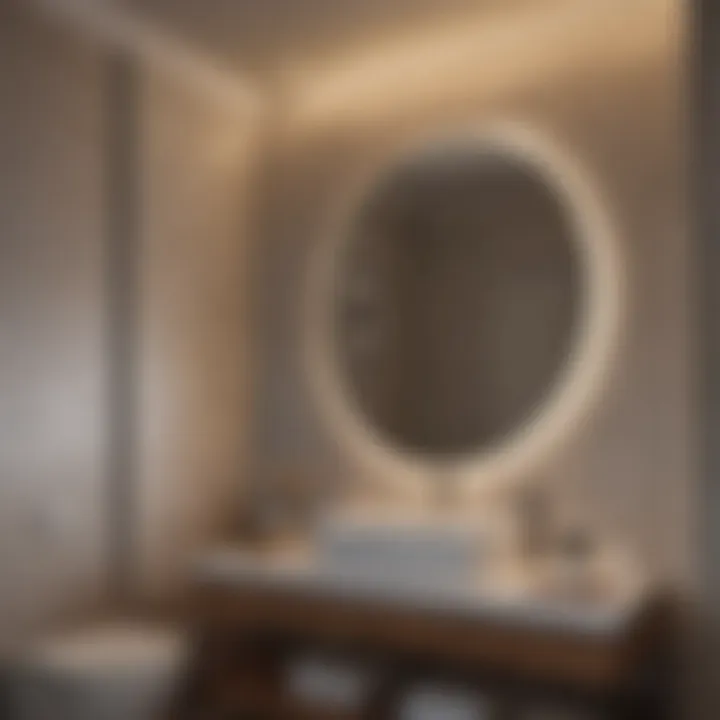
Consider the various elements that contribute to effective bathroom lighting. Here are some key factors:
- Type of Light Fixtures: From overhead lights to wall sconces, the type of light fixtures should reflect the bathroom’s design style, be it modern or traditional.
- Light Temperature: The color temperature of your bulbs matters. Cooler tones can invigorate, while warmer tones can relax. A warm white might be perfect for creating a softer atmosphere in the evening.
- Placement: How and where you position lights can significantly affect shadows and visibility. Lights placed above mirrors can minimize shadowing, enhancing your reflection.
Due attention to lighting can turn an otherwise cramped space into a radiant, welcoming area.
The Role of Natural Light
Harnessing natural light is one of the most effective strategies for brightening up a small bathroom. If your tiny space has a window, you’re sitting on a goldmine. Natural light opens up corners and makes walls recede visually, combating that enclosed feeling often associated with small areas.
You can maximize this natural advantage by using sheer or light-filtering window treatments, allowing as much light as possible to flow in while ensuring some level of privacy. Mirrors also become best friends to natural light; placing one opposite the window can reflect light back into the room, further enhancing brightness.
Beyond aesthetics, natural light contributes positively to one’s mood and well-being. According to various studies, exposure to sunlight can lower stress levels and improve overall energy, making your morning routine feel less like a chore.
Layered Lighting Approaches
Now, let’s delve into layered lighting approaches, a design method that can elevate the functionality and aesthetic appeal of your bathroom. Layering involves mixing different types of lighting—ambient, task, and accent—to create a more dynamic and versatile space. Here’s how you can break it down:
- Ambient Lighting: This is your general light source. Think overhead fixtures or recessed lighting that provide a soft glow to light the whole area evenly. In a small bathroom, maximizing this aspect is vital.
- Task Lighting: Consider this your focused lighting. It should illuminate specific areas where you perform tasks, like grooming or reading. Wall-mounted fixtures beside the mirror or lights above the sink would work wonders here.
- Accent Lighting: This adds visual interest and drama. It can highlight shelves, artwork, or unique architectural features. While it might not seem essential, in a tiny bathroom, a strategic spotlight can draw attention away from size limitations and onto stylish design elements.
In more technical terms, a carefully strategized combination of these layers leads to an adaptable space, where you can adjust the mood and functionality according to your needs. Therefore, the right lighting can transform your tiny bathroom into a multi-functional gem.
The way you light your small space determines not just how it looks, but how it feels.
Accessorizing the Space
Accessorizing a small bathroom may seem like adding a few finishing touches, but it's much more than that. These elements can substantially influence the overall feel and functionality of the space. Accessories serve several roles: they can enhance organization, add personality, and ultimately transform a cold, utilitarian space into an inviting retreat. The right accessories can squeeze every bit of potential from your tiny area, making it not just livable but enjoyable.
Essentially, this is the section where you can really let your creativity flow. Small spaces call for careful consideration of what you include. Overdo it, and your tiny oasis quickly becomes cluttered and overwhelming. Therefore, it's wise to strike a balance between essential pieces and decorative ones. Choosing the right accessories also supports the practicality of the space; for instance, opting for multi-functional items can free up valuable surface areas.
Choosing Functional Accessories
When it comes to selecting accessories, functionality should reign supreme. There's no point in having beautiful items that serve no purpose, especially in a small bathroom where space is limited. Think about items that pull double duty. A stylish basket that houses towels or toiletries not only serves its purpose well but also adds texture and warmth to the overall design.
"In a tiny bathroom, each accessory counts. Choose wisely."
Here are some ideas on functional accessories:
- Storage Baskets: Having baskets or bins that fit neatly on shelves or under sinks solves storage issues while keeping the style intact. Opt for baskets that come in natural materials to soften the visual appeal of hard surfaces.
- Magnetic Strips: Cleverly use magnetic strips for holding small metallic items like tweezers and scissors, freeing up drawer space.
- Tiered Shelving: These can add extra space without taking up too much floor area, especially useful for decorative plants or a carefully curated display of bath essentials.
- Wall-mounted Organizers: Whether for toiletries or cleaning supplies, wall organizers keep everything tidy and within reach, making daily routines smoother.
Integrating Personal Elements
Accessorizing is also an opportunity to showcase your personality and make the space uniquely yours. When you add personal touches, it creates warmth and invites a sense of comfort that is often missing in a space dominated by sterile fittings.
Start by considering items that tell your story—these could be family photographs, travel souvenirs, or art pieces you adore. Even subtle items like a custom soap dispenser or uniquely patterned towels can make a world of difference.
Some tips to integrate personal elements:
- Artwork: Adding a small framed piece of art or a decorative mirror can enhance your bathroom's aesthetics, drawing the eye and serving as a conversation starter.
- Plants: Consider low-maintenance plants like succulents or ferns to bring in a touch of nature. They not only purify the air but also exhibit a sense of care for your environment.
- Custom Textiles: Unique shower curtains or towels that feature colors or designs you love can infuse life into the bathroom while echoing various design trends.
- DIY Projects: If you have the knack for hands-on creativity, consider a DIY shelving unit or wall art that aligns with your decor style.
In essence, accessorizing your space responsibly means supporting functionality while allowing your individual style to shine through. By weighting both aspects equally, you ensure a space that's optimized for both efficiency and aesthetic delight, regardless of its size.
Sustainability in Small Bathrooms
When it comes to designing a tiny bathroom, sustainability isn't just a passing trend—it's essential. Integrating eco-friendly elements in a limited space can lead to various benefits. First, it reduces environmental impact while creating a comfortable atmosphere that you and your family can enjoy. Small changes can have a sizable effect, encouraging both conservation and style.
Moreover, sustainable materials are often more durable. When you opt for products that stand the test of time, you’re not just reducing waste; you’re also making a smart financial decision for your household. Sustainability in small bathrooms means being mindful of choices that not only beautify the space but also contribute to a healthier planet.
Eco-friendly Materials and Products
Selecting the right materials can make or break the sustainability aspect of your bathroom. Instead of traditional plastics, consider using bamboo or recycled glass for shelving and decor. They are sturdy, stylish, and boast minimal environmental footprints. Opting for low-VOC paints is another way to keep air quality in check. These will keep nasty chemicals at bay, making your space not just look good but feel good too.
Some might not realize that ceramic tiles, especially those made from recycled materials, are a versatile choice as well. They’re not only appealing but last for years. Likewise, using sustainable textiles such as organic cotton towels is a small step that pays dividends.
"Sustainable living doesn’t have to be complicated; sometimes all it takes are small, informed choices to drive bigger changes."
Water-saving Fixtures


Water usage in the bathroom is often significant, so switching to water-saving fixtures can have a hefty impact on your water bill aaand the environment. Low-flow toilets are an obvious choice; they use a fraction of the water that traditional toilets do. You can find models with dual-flush options that let you choose between light and heavy flushes, optimizing usage.
Water-efficient faucets and showerheads are equally vital. Look for ones marked with the WaterSense label, indicating that they meet federal water efficiency and performance criteria. They can cut down water use while still providing a satisfying experience.
Additionally, consider installing a rainwater collection system. While this may involve a bit more effort, the benefits of using collected rainwater for flushing toilets or watering plants are worth it. You create a sustainable loop, reusing water that would otherwise go to waste.
Maintaining a Clean and Organized Space
Maintaining a clean and organized space in a tiny bathroom is not just about aesthetics. It influences functionality, efficiency, and even mental well-being. When every inch counts, the chaos of clutter can quickly become overwhelming. By prioritizing cleanliness, you ensure that the space feels more open and inviting, while also making it easier to find essentials when you need them.
The benefits of keeping a tidy bathroom are numerous. For one, it reduces the likelihood of accidents. A clean floor without stray towels or toiletries can be crucial in avoiding slips. Further, a clutter-free zone can enhance relaxation. Imagine stepping into a space where everything is in its rightful place—there’s an immediate sense of calm.
Among the elements to consider in organizing a small bathroom is the idea of routine cleaning. Short, consistent efforts can lead to a substantial difference over time. In addition, decluttering techniques play a pivotal role in maintaining order, allowing the bathroom to reflect tranquility rather than chaos.
"Cleanliness is next to godliness," as the saying goes, holds true especially for small spaces where disorder can feel suffocating.
Routine Cleaning Strategies
Establishing a regular cleaning routine can help in keeping your tiny bathroom fresh and presentable. It doesn’t have to be an arduous task; instead, it can be broken down into manageable bits. Here are some effective strategies:
- Daily Pick-up: Dedicate a few minutes each day to pick up wandering items—this could be a towel left on the floor or a toothbrush out of place. A quick once-over can make a world of difference.
- Surface Wipe-downs: Invest in multi-surface cleaning wipes or a spray that tackles multiple areas. Wipe down counters, sinks, and mirrors daily to prevent grime buildup.
- Weekly Deep Clean: Schedule a more thorough cleaning session weekly. This can include scrubbing tiles, disinfecting the toilet, and cleaning out the shower space thoroughly.
- Monthly Maintenance: Once a month, focus on details like washing bath mats, cleaning out storage, and checking for expired products.
Implementing these routines means that tasks can eventually become second nature, reducing the headache often associated with cleaning.
Decluttering Techniques
Decluttering can feel like a daunting affair, especially in a small bathroom where space is precious. However, effective techniques can simplify this process.
- Limit Personal Items: Identify daily essentials and keep only those within arm's reach. Store away seasonal or seldom-used items, such as lotions for specific occasions or special towels.
- Use Bins or Baskets: Invest in attractive bins or baskets that can hold items while keeping them out of sight. This also adds a decorative touch to your space.
- Go Vertical: Take advantage of vertical space by utilizing shelves or hanging organizers. This way, you free up counter and floor space, making your bathroom appear larger while keeping it organized.
- Regular Assessments: Every few months, go through your items. Dispose of any personal care products that haven’t been used in the last year.
Keeping a clean and organized bathroom is a continuous effort, yet the results can be immensely rewarding. By following strategies for routine cleaning and effective decluttering techniques, a small space can transform into a serene and welcoming haven.
Adapting Trends to Fit Your Style
In the world of interior design, trends can be as ephemeral as a pop song. However, when it comes to decorating a tiny bathroom, adapting those trends thoughtfully can create a space that is not only stylish but also functional and reflective of your unique aesthetics. While following the latest trends in bathroom design can make a space feel contemporary, it's equally crucial to ensure these trends align with your personal style and the practical needs of your home.
Selecting design elements that resonate with your taste allows you to create a harmonious atmosphere, where the current trends marry with your individual sensibilities. You might find that certain trends elevate the otherwise mundane aspects of a tiny bathroom, making it feel larger or more inviting. Think of it like dressing for the occasion; you wouldn’t wear a three-piece suit to a beach picnic, right? Similarly, your bathroom decor should suit your lifestyle.
Contemporary vs. Classic Decor
When considering how to adapt trends to your small bathroom, it’s essential to weigh the balance between contemporary designs and classic touches. Contemporary decor embraces minimalism, clean lines, and often incorporates modern materials such as glass and metals. This aligns well with smaller spaces—where every square inch counts—as streamlined solutions can create an airy feel.
Conversely, classic decor draws on traditional elements and timeless shapes. It might include vintage fixtures or intricate tile work that holds a story. This can provide a rich character, making your tiny space feel warm and inviting. By melding these styles, you might opt for modern fixtures paired with classic tiles, creating a bridge between old and new. It’s like preparing a fine meal; you want to add flavors that complement each other. The key is to appreciate what each style brings and how they can coexist without causing a clash.
Mixing Patterns and Textures
Not all mixing and matching has to be a recipe for disaster. In fact, when done correctly, blending different patterns and textures can breathe life into your tiny bathroom. Consider incorporating a variety of materials—perhaps smooth ceramic tiles for the floor paired with a tactile, woven rug for an element of surprise. Don’t shy away from prints either, as wallpapers can easily transform a small space into a devoted nook with whimsy.
"The real trick is to maintain a sense of cohesion. If one pattern is bold, balance it with subtler elements to avoid overwhelming the senses."
For an even bolder statement, consider mixing geometric tile patterns with softer, flowing elements like round mirrors or oval sinks. This creates a dynamic conversation within the room while ensuring no single element steals the show. Just like a skilled conductor keeps an orchestra in harmony, mixing patterns and textures wisely can make a small bathroom sing.
In summary, adapting trends to fit your personal style and the needs of a small space will allow you to curate an environment that is both fashionable and functional. It’s about finding that sweet spot between the trendy and the personal, ensuring your tiny bathroom becomes a haven rather than an afterthought.
End
When it comes to transforming a tiny bathroom, every detail counts. This concluding section of the article emphasizes the importance of adopting a comprehensive approach to decorating small spaces while honing in on the specific elements that contribute to an effective and inviting bathroom environment.
Summing Up Key Principles
First and foremost, it's crucial to remember the key principles outlined in this article. These include:
- Maximizing Space: Implement smart storage solutions, such as vertical shelving and multifunctional furniture. This ensures that every nook and cranny is utilized effectively.
- Effective Use of Color and Light: Light-colored paints and strategic lighting can work wonders to make a small bathroom feel more open. Natural light, whenever possible, should be embraced to enhance the ambiance.
- Selecting Appropriate Fixtures: Opt for compact fixtures that do not compromise on functionality. This means choosing smaller sinks, toilets, and bathtubs that fit seamlessly into the limited space.
- Incorporating Personal Touches: Accessories can significantly elevate the space’s aesthetics. Personal elements allow individuals to convey their unique style, making the bathroom a true reflection of the homeowner’s taste.
By integrating these principles consistently during the decorating process, homeowners can create a space that appears larger, feels more organized, and helps radiate tranquility. Viewed holistically, it's these small moves that combine to produce a significant transformation.
Encouragement for Personal Expression
Each tiny bathroom has its own potential waiting to be unleashed. One of the most rewarding aspects of decorating such a space is the opportunity to express personal style and preferences. Don’t rush the process; let the bathroom evolve into a sanctuary suited to your lifestyle. Consider these points while personalizing your space:
- Choose Themes That Resonate: Whether it’s a minimalist vibe or a vintage look, pick a theme that truly speaks to you. This could mean selecting specific patterns, colors, or even materials that evoke desired feelings.
- Incorporate Unique Accessories: Forget about cookie-cutter designs; hunt for distinctive pieces that tell a story or hold sentimental value. A family heirloom or a traveler’s souvenir can add character and warmth.
- Experiment with Layouts: Sometimes a quirky approach can yield fantastic results. Don't be afraid to play around with layouts to create an unexpected, but harmonious arrangement.
- Change is Not Final: Don’t hesitate to refresh decorations or switch items seasonally. This adaptability can keep the space lively and engaging, making the bathroom an ever-evolving expression of your ideals.
Remember, it's not just about function but also about feeling. A bathroom can be both useful and soothing if your personal touch drives the design.
Ultimately, if you embrace these concepts, you'll find that even the smallest spaces can exude both functionality and style. The goal is to cultivate a space where practicality meets personal expression, resulting in a bathroom that feels like a delightful retreat rather than just a necessity.



